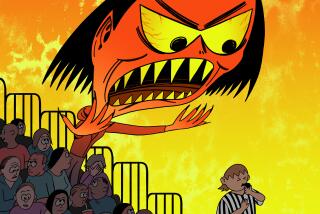Personal Health : Big-League Child Injuries : Doctors Lay Blame for Growing Number of Orthopedic Cases
- Share via
Say hello to another phenomenon of the ‘80s: sports injuries in children.
Today’s kids, who used to get their bumps and bruises by riding bikes or roller skates around the neighborhood, are instead sustaining orthopedic injuries that once were the province of adult weekend warriors: overuse injuries caused by too much activity of a single type or over too short a period of time.
Doctors blame the disturbing trend of sedentary life styles and improper coaching, but they also point to modern social phenomena such as the increase in two-career and single-parent families, latch-key kids and fear for children’s safety.
Says Dr. Lyle Micheli, director of sports medicine at Children’s Hospital in Boston, “I hear repeatedly kids saying, ‘My Mom won’t let me go outside and play. She wants me to come home from school, lock the door and don’t go outside, and watch television until she comes home from work.’ ”
Concern about safety and unstructured time makes organized sports more attractive than simply allowing young children to get the exercise they need by playing freely outdoors, says Micheli.
In addition, parents want their kids to be fit, and organized sports are a solution. There are 20 million children in organized, out-of-school sports, the National Youth Sports Coaches Assn. estimates.
No organization keeps statistics on children’s sports-related overuse injuries, and sports medicine for elementary- and junior-high school age children remains a rare specialty. But Micheli says that at his clinic, one of the few in the nation, overuse or repetitive strain injuries in children quadrupled over the last decade, to about 400 children a week.
In Los Angeles, Childrens Hospital is seeing enough patients that orthopedics surgery chief Dr. Vernon Tolo plans to set up a sports medicine clinic within the next two years.
And the National Institute of Arthritis and Musculoskeletal and Skin Diseases in Bethesda, Md., is considering a major long-term study to see whether sports injuries in young children are leading to joint problems such as arthritis in adulthood, said Reva C. Lawrence, epidemiology program officer for the institute.
The new kind of kids’ sports injury might take the form of:
* The tendinitis of a 12-year-old pitcher, who plays in fall and spring leagues, then goes to an intensive baseball camp in the summer.
* The painful spine in a slender gymnast who trains for hours daily because her parents and coach think she has the right stuff for the next Olympics.
* The stress fracture in a young couch potato whose parents wanted to get him into shape by signing him up for a competitive soccer team.
“If you have a kid who has been deconditioned by inactivity--rides the bus to school rather than walking . . . less physical activity through the day--their tissues are weaker,” Micheli said.
Micheli says such children face a double risk of injury. Not only are their bodies unprepared for vigorous exercise but the nature of team sports tends to cause them to stress the same muscles, tendons and bones over and over again. “The bottom line is kids never used to get these injuries,” he said.
He and others predict the number of overuse injuries will continue to grow because parents want their children to be fit but often are unaware they must prepare them for the rigors of organized sports. Part of the increase in children’s orthopedic injuries may be attributable simply to doctors’ heightened sensitivity to and detection of them, said Dr. Arthur Pappas, a University of Massachusetts orthopedic surgeon who serves on the American Academy of Pediatrics’s sports committee.
But there has been an unequivocal increase, he says, in injuries to single-sport athletes who specialize by age 10-12 and train intensively. Ballet dancers. Figure skaters. Gymnasts. Tennis players. Swimmers.
“Those are the kids, who because of a total overload of their physical structures, are more likely to start having injuries and musculoskeletal complaints,” he said. They “go off and start training when they’re very young. Most bodies aren’t meant to take that.”
Preventing Injuries
To protect youngsters, most sports safety efforts have focused on trying to prevent impact injuries. In football, great emphasis has been put on players wearing proper padding, and “spearing” with the head has been banned because it causes neck injuries; in soccer, competitors don shin guards; in baseball, batters must wear helmets to protect them from being beaned.
Though baseball organizations have recognized one common overuse problem by limiting the number of innings a pitcher can play (Little League allows six innings of pitching per week), coaches and parents must do more to recognize and avert the types of overuse or repetitive strain injuries now being seen, doctors and athletic trainers say.
They recommend limiting practices to two or three times a week and to no more than two hours (even less for the youngest children), and they advise against letting elementary school children participate in a single sport year-round. In junior high, there is increasing pressure for specialization, Micheli noted, but he said it is best if children avoid it before age 14.
John Powell, an athletic trainer and orthopedic researcher at the University of Iowa Hospital, said a player’s slight limp or minor pain can indicate “microtrauma,” small injuries that can add up over time to cause serious problems. The standard treatment is to decrease the child’s activity level for a few days to allow the body to heal.
When ignored, microtraumas can result in major impact injuries a few days later, puzzling onlookers who observe of the child, “he wasn’t hit that hard,” Powell said.
Any sports-related pain that doesn’t respond to rest needs a doctor’s attention, he and others agreed.
Parents and coaches, they emphasized, should not encourage young players to continue playing despite pain. This can cause damage leading to joint immobility, arthritis and other movement problems later in life.
“When a parent says to a child, ‘Don’t be a sissy,’ the child eventually will learn not to go to the parent, and will not go to someone when injury occurs. They’ll hide it, mask it, try to play through it,” said Paul Grace, an athletic trainer, researcher and coordinator of sports medicine at the Massachusetts Institute of Technology. “The long-term effect of that is we have an athlete who has the knees or shoulder or back of a 40-year-old when they’re 19.”
Anatomy of the Problem
Children’s rapid growth, particularly near puberty, also makes overuse and impact injuries more likely, research indicates.
In a child’s skeleton, the bones still are growing. Growth plates at the end of long bones in the arms and legs are made of cartilage, which is weaker than the adjoining bone and more susceptible to microfractures.
Injury risk also increases during growth spurts that put muscles, tendons, ligaments and bones out of balance. Micheli suggests, for instance, that tight muscle-tendon structures, a condition that can occur during growth spurts, increase the chances of stress fractures in associated bones.
A 1988 French study found that, among 11 soccer players with growth plate or cartilage injuries, bone development was 15-16 months behind the child’s growth in overall body size and strength. A 1988 study at the University of Washington found that strain in the quadriceps, the large muscle at the front of the thigh, was greatest in boy soccer players who were tall but whose muscles had not gained proportional strength.
Overtraining, inappropriate training or raising activity levels too rapidly during those fast-growth times increases the injury risk even more, doctors say.
Concern about overuse or repetitive strain injuries comes just as sports programs for pre-adolescent children have instituted rules that have helped to cut the risk of impact injuries, particularly in football.
Between 1980 and 1988, the annual number of emergency-room treated injuries among 5- to 14-year-old football players decreased 26%, from 173,100 to 127,250, the Consumer Product Safety Commission reports. In baseball, emergency-room treated injuries declined 13% in the same period, to 105,450. Soccer injuries rose 7%, to 40,620.
Additional Safety Measures
Some studies have suggested additional measures in baseball and soccer to prevent serious impact injuries, particularly among junior high school children whose increasing size and strength raise the potential for serious harm.
These include chest padding for batters (children’s chest bones are more elastic than an adult’s, so impact from a pitch can result in a fatal heart attack); breakaway bases to prevent knee injuries in slides; and mouthpieces for soccer players to prevent teeth injury in collisions. Some also advocate protective eye wear for batters and soccer players.
Although such injury questions can be controversial, they are easier for coaches and parents to address than overuse trauma: It’s self-evident a padded helmet will prevent a child’s head from damage; it’s less apparent that a level practice field, appropriate shoes and the right equipment will prevent damaged tendons or stress fractures.
A young athlete also needs plenty of sleep, at least 24 hours of rest between strenuous activities (often more) and a balanced diet that adds extra complex carbohydrates after a practice or game. Grace recommends: “We know that when you perform a sport like soccer you do use quite a bit of energy. If you go back and you start training in a different activity the next day, and you don’t have the proper fuel in the body, it’s a cumulative effect--which will foster problems later down the line.”
He believes every children’s sports league should provide parents with information about avoiding injuries through proper preparation, and also should have a dietitian, athletic trainer or pediatrician who can answer questions.
At the same time, doctors and trainers emphasize that they aren’t arguing against sports for children. Properly done, physical fitness training gives a child healthier bones and muscles, a stronger heart and life-style habits in adulthood that reduce the risks of heart attack, stroke, cancer and other chronic disease.
“There is certainly no clear evidence that organized sports are more dangerous, or safer, than free play,” Micheli wrote in a 1983 paper. “Children can break their arms while playing Pop Warner football or by falling out of a tree, and the relative risks may be similar.”
Said Powell: “That risk, managed properly, is beneficial risk, not detrimental risk.”






